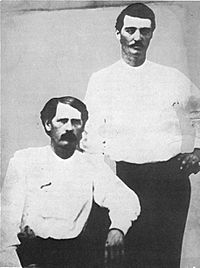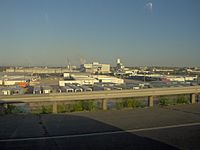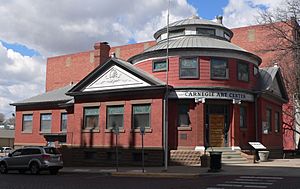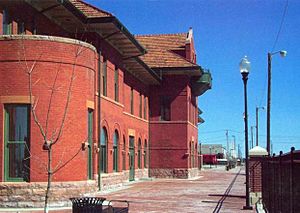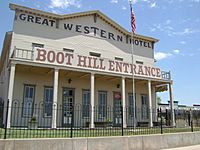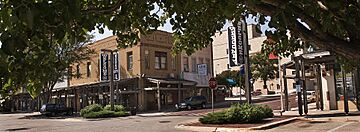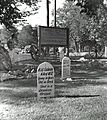Dodge City, Kansas facts for kids
Quick facts for kids
Dodge City, Kansas
|
|||
|---|---|---|---|
|
City and County seat
|
|||
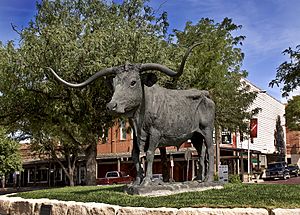
El Capitan cattle drive monument (2008)
|
|||
|
|||
| Nickname(s):
"Cowboy Capital of The World"; "Wicked Little City"; "King of Cowtowns"
|
|||
| Motto(s):
"Get The Heck Into Dodge";
"The Wickedest Little City in America" |
|||
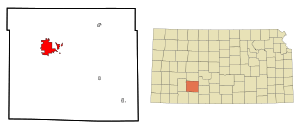
Location within Ford County and Kansas
|
|||
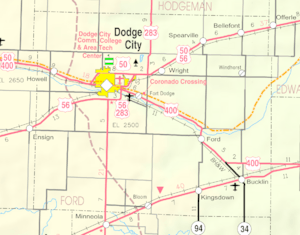
|
|||
| Country | United States | ||
| State | Kansas | ||
| County | Ford | ||
| Founded | 1872 | ||
| Incorporated | 1875 | ||
| Named for | Fort Dodge | ||
| Area | |||
| • Total | 14.77 sq mi (38.24 km2) | ||
| • Land | 14.66 sq mi (37.97 km2) | ||
| • Water | 0.10 sq mi (0.27 km2) | ||
| Elevation | 2,559 ft (780 m) | ||
| Population
(2020)
|
|||
| • Total | 27,788 | ||
| • Density | 1,881.4/sq mi (726.67/km2) | ||
| Time zone | UTC−6 (CST) | ||
| • Summer (DST) | UTC−5 (CDT) | ||
| ZIP codes |
67801, 67843
|
||
| Area code | 620 | ||
| FIPS code | 20-18250 | ||
| GNIS ID | 485563 | ||
Dodge City is a city in Ford County, Kansas, United States. It is also the county seat, which means it is the main town for local government. In 2020, about 27,788 people lived there. The city got its name from a nearby army base called Fort Dodge. This base was named after a person named Grenville Dodge. Dodge City is famous in American culture because of its exciting past as a frontier town in the Old West.
Contents
History of Dodge City
Early Settlements and Forts
The first settlement by non-Native Americans in the Dodge City area was Fort Mann. Civilians built it in 1847 to protect travelers on the Santa Fe Trail. Fort Mann was destroyed in 1848 after an attack by Native Americans.
In 1850, the U.S. Army built Fort Atkinson on the same spot to offer protection. The army left Fort Atkinson in 1853. Later, in 1859, military forces returned to the Santa Fe Trail at Fort Larned.
After the Civil War, in April 1865, conflicts with Native American tribes increased. The army built Fort Dodge to help Fort Larned protect the Santa Fe Trail. Fort Dodge stayed open until 1882.
How Dodge City Began
The town of Dodge City started in 1871. A rancher named Henry J. Sitler built a small house made of sod west of Fort Dodge. He used it to manage his cattle. His house was a good stopping point for travelers because it was near the Santa Fe Trail and the Arkansas River.
Others soon saw that the area had great business potential. The Santa Fe Railroad was quickly building tracks from the east. In 1872, Dodge City was officially marked out. It was located on the 100th Meridian, which was the western edge of the Fort Dodge reservation.
George M. Hoover opened the first bar in a tent to serve soldiers from Fort Dodge. When the railroad arrived in September, the town was ready for business. Early settlers traded in buffalo bones and hides. They also provided a community for Fort Dodge. With the railroad, Dodge City quickly became important for the cattle trade.
Dodge City and the Cattle Drives
The idea of moving Texas longhorn cattle from Texas to Kansas railroads began in the late 1850s. But the Civil War stopped it. In 1866, the first Texas cattle arrived in Baxter Springs using the Shawnee Trail.
However, Texas longhorn cattle carried tiny ticks. These ticks spread a disease called splenic fever, also known as Texas Fever, to other cattle breeds. Kansas farmers were worried. They convinced the Kansas State Legislature to create a quarantine line in central Kansas. This line stopped Texas longhorns from entering the eastern, more settled parts of the state.
Because of the quarantine, the cattle trade had to move west. Texas longhorns started moving north along the Chisholm Trail. In 1867, Abilene, Kansas was the main "cow town." Many towns joined the cattle boom, like Newton in 1871, Ellsworth in 1872, and Wichita in 1872.
In 1876, the Kansas State Legislature moved the quarantine line even further west. This change basically ended the cattle trade for Abilene and other cow towns. With nowhere else to go, Dodge City suddenly became the most important "queen of the cow towns."
A new path called the Great Western Cattle Trail or Western Trail branched off from the Chisholm Trail. It led cattle directly to Dodge City. Dodge City became a very busy town, with thousands of cattle passing through its stockyards each year. The busiest years for the cattle trade in Dodge City were from 1883 to 1884. During this time, the town grew a lot.
In 1880, Caldwell became a new competitor for the cattle trade. For a few years, the towns competed fiercely. But there were enough cattle for both to do well. Still, Dodge City became more famous. No other town could match Dodge City's reputation as a true frontier settlement of the Old West. Many famous lawmen and gunfighters worked in Dodge City at different times.
Geography and Climate
Where is Dodge City?
Dodge City is located at 37°45′35″N 100°1′6″W / 37.75972°N 100.01833°W. It is about 2,493 feet (760 meters) above sea level. The city is on the Arkansas River in the High Plains area of the Great Plains. It sits above the Ogallala Aquifer, one of the world's largest underground water systems.
The city covers about 14.55 square miles (37.68 square kilometers). Most of this area is land, with a small amount of water.
Dodge City's Weather
Dodge City has a mix of semi-arid and humid subtropical climate. This means it has hot summers and winters that can be warm or very cold. The air is usually not too humid, and there is a low to moderate amount of rain and snow throughout the year.
Dodge City is known for being one of the windiest cities in the United States. The average wind speed is about 13.9 miles per hour (22.4 km/h). This can cause blizzards in winter, even if there isn't a lot of snow.
The coldest month is usually January, and the hottest is July. June is typically the wettest month. Temperatures often reach or go above 90°F (32°C) about 67 days a year. They can reach 100°F (38°C) about 13 days a year. The lowest temperature ever recorded was -26°F (-32°C) in February 1899.
Dodge City gets about 21.6 inches (549 mm) of rain each year. Most of this rain falls from May to August. It snows about 21.1 inches (53.6 cm) per winter season.
| Climate data for Dodge City Regional Airport, Kansas (1981–2010 normals, extremes 1874–present) | |||||||||||||
|---|---|---|---|---|---|---|---|---|---|---|---|---|---|
| Month | Jan | Feb | Mar | Apr | May | Jun | Jul | Aug | Sep | Oct | Nov | Dec | Year |
| Record high °F (°C) | 80 (27) |
86 (30) |
98 (37) |
100 (38) |
106 (41) |
111 (44) |
109 (43) |
109 (43) |
107 (42) |
99 (37) |
91 (33) |
86 (30) |
111 (44) |
| Mean daily maximum °F (°C) | 44.2 (6.8) |
48.4 (9.1) |
57.8 (14.3) |
67.5 (19.7) |
76.9 (24.9) |
86.7 (30.4) |
92.8 (33.8) |
90.8 (32.7) |
82.4 (28.0) |
69.7 (20.9) |
55.9 (13.3) |
44.3 (6.8) |
68.2 (20.1) |
| Mean daily minimum °F (°C) | 20.1 (−6.6) |
23.4 (−4.8) |
31.0 (−0.6) |
40.2 (4.6) |
51.5 (10.8) |
61.0 (16.1) |
66.3 (19.1) |
65.3 (18.5) |
56.0 (13.3) |
43.4 (6.3) |
30.3 (−0.9) |
21.2 (−6.0) |
42.6 (5.9) |
| Record low °F (°C) | −20 (−29) |
−26 (−32) |
−15 (−26) |
9 (−13) |
19 (−7) |
36 (2) |
46 (8) |
43 (6) |
29 (−2) |
10 (−12) |
−13 (−25) |
−21 (−29) |
−26 (−32) |
| Average precipitation inches (mm) | 0.58 (15) |
0.68 (17) |
1.59 (40) |
1.82 (46) |
2.85 (72) |
3.24 (82) |
3.08 (78) |
2.75 (70) |
1.67 (42) |
1.74 (44) |
0.76 (19) |
0.84 (21) |
21.60 (549) |
| Average snowfall inches (cm) | 4.9 (12) |
3.9 (9.9) |
4.9 (12) |
1.1 (2.8) |
0 (0) |
0 (0) |
0 (0) |
0 (0) |
0 (0) |
0.4 (1.0) |
1.8 (4.6) |
4.1 (10) |
21.1 (54) |
| Average precipitation days (≥ 0.01 in) | 3.5 | 4.8 | 6.5 | 7.1 | 8.9 | 8.9 | 8.2 | 8.0 | 5.7 | 6.1 | 4.5 | 4.6 | 76.8 |
| Average snowy days (≥ 0.1 in) | 3.4 | 2.8 | 2.3 | 0.6 | 0 | 0 | 0 | 0 | 0 | 0.2 | 1.2 | 3.2 | 13.7 |
| Average relative humidity (%) | 65.9 | 64.5 | 60.5 | 57.5 | 62.5 | 59.9 | 55.2 | 58.4 | 61.9 | 58.2 | 64.3 | 66.6 | 61.3 |
| Mean monthly sunshine hours | 207.2 | 201.6 | 241.1 | 270.0 | 297.6 | 332.9 | 357.8 | 319.0 | 267.6 | 248.8 | 192.9 | 189.2 | 3,125.7 |
| Percent possible sunshine | 67 | 67 | 65 | 68 | 68 | 75 | 80 | 76 | 72 | 71 | 63 | 63 | 70 |
| Source: National Weather Service (relative humidity and sun 1961–1990), The Weather Channel | |||||||||||||
People of Dodge City
| Historical population | |||
|---|---|---|---|
| Census | Pop. | %± | |
| 1880 | 996 | — | |
| 1890 | 1,763 | 77.0% | |
| 1900 | 1,942 | 10.2% | |
| 1910 | 3,214 | 65.5% | |
| 1920 | 5,061 | 57.5% | |
| 1930 | 10,059 | 98.8% | |
| 1940 | 8,487 | −15.6% | |
| 1950 | 11,262 | 32.7% | |
| 1960 | 13,520 | 20.0% | |
| 1970 | 14,127 | 4.5% | |
| 1980 | 18,001 | 27.4% | |
| 1990 | 21,129 | 17.4% | |
| 2000 | 25,176 | 19.2% | |
| 2010 | 27,340 | 8.6% | |
| 2020 | 27,788 | 1.6% | |
| U.S. Decennial Census 2010-2020 |
|||
Population in 2020
The 2020 United States census counted 27,788 people living in Dodge City. There were 9,000 households and 6,399 families. The population density was about 1,888 people per square mile (729/km2).
Many different groups of people live in Dodge City. About 44.58% of the people were white. About 3.39% were black. About 2.43% were Native American. About 1.38% were Asian. A large part of the population, 63.91%, was Hispanic or Latino.
About 31.7% of the population was under 18 years old. The average age was 30.0 years. For every 100 females, there were about 96.9 males.
Population in 2010
In the 2010 United States Census, there were 27,340 people in Dodge City. The population density was about 1,893 people per square mile (731/km2).
The racial makeup included 72.5% White people. About 2.5% were African American. About 1.1% were Native American. About 1.6% were Asian. Hispanics and Latinos made up 57.5% of the population.
About 31.8% of residents were under 18 years old. The average age was 28.9 years.
Economy and Jobs
Meat packing is the biggest industry in Dodge City. Companies like Cargill Meat Solutions and National Beef have large factories here. The city also makes farm implements and helps support local farms.
Raising Livestock (like cattle) is a major activity. Wheat and sorghum are the main crops grown in the area. Dodge City also has a growing tourism industry. People visit to learn about its history as an Old West cow town. There is even a casino resort.
In 2023, Hilmar Cheese plans to open a large new cheese and whey protein factory in Dodge City. This will bring more jobs to the city.
Major Employers
The two largest employers in Dodge City are Cargill Meat Solutions and National Beef. Other big employers include:
- Local government
- Schools
- Retail stores
- Health care providers
Education in Dodge City
Schools for Kids
The Dodge City USD 443 public school district serves over 6,000 students. It has 14 schools in the city. These include:
- One early childhood center
- Eight elementary schools
- Two middle schools
- One high school
- One alternative school
The Roman Catholic Diocese of Dodge City also runs one Catholic school in the city. It is called Sacred Heart Cathedral School and teaches students from pre-kindergarten to 8th grade.
Colleges and Libraries
Dodge City Community College (DCCC) is a two-year public college. It has about 2,000 students and is in the northwest part of the city. Newman University also has a branch campus here.
The Dodge City Public Library is the city's main library. It has about 123,000 books and other items. It was first a Carnegie library built in 1905. The library offers computer classes, public internet access, and programs for all ages.
Transportation
Dodge City was an important stop on the Santa Fe Trail. Today, four U.S. Highways meet in Dodge City: U.S. Route 50, U.S. Route 56, U.S. Route 283, and U.S. Route 400.
The Dodge City Regional Airport is about 2 miles (3.2 km) east of the city. It is mainly used for private planes. There is also one commercial airline that flies daily to Denver, Colorado.
Three railroads serve Dodge City: the BNSF Railway, the Cimarron Valley Railroad, and the Boot Hill and Western Railway. Amtrak offers passenger train service on its Southwest Chief line, which travels between Chicago and Los Angeles. The Amtrak station is downtown.
The city also has a bus service called D-TRAN. It runs Monday through Friday.
Media and News
Dodge City is a center for radio and TV in southwestern Kansas.
- The Dodge City Daily Globe is the city's daily newspaper.
- The Southwest Kansas Catholic is a weekly newspaper published by the Roman Catholic Diocese of Dodge City.
- The High Plains Journal is a weekly magazine about farming news in the region.
There are also several radio and television stations that broadcast from Dodge City.
Fun Things to Do
Parks and Sports
The city has 21 parks. The biggest is Wright Park, which is home to the Dodge City Zoo. Legends Park has baseball and softball fields for youth and adult games. The city also has the St. Mary Soccer Complex and a public swimming pool.
There are two golf courses:
- Mariah Hills Municipal Golf Course (public, 18 holes)
- Dodge City Country Club (private, 18 holes)
Dodge City Community College's sports teams are called the Dodge City Conquistadors, or "Conqs." They play in the KJCCC.
Dodge City also has amateur baseball and professional car racing. The Dodge City Athletics baseball team plays at Cavalier Field. Dodge City Raceway Park is a dirt track for midget and sprint car racing.
Arts and Events
Dodge City has a lively arts scene.
- The Carnegie Center for the Arts shows art by local artists.
- The Second Avenue Art Guild shows art by regional artists.
- The Depot Theater Company puts on plays throughout the year.
Each summer, the Dodge City Chamber of Commerce holds Dodge City Days. This ten-day festival includes:
- The Dodge City Roundup Rodeo
- A parade
- Music concerts
- Art shows
- Other fun activities
Other events include:
- Cinco de Mayo celebrations in Wright Park.
- An Old-Fashioned Fourth of July with fireworks.
- Christmas in Old Dodge City, a winter holiday festival.
Two annual events celebrate farming:
Places to Visit
Dodge City has many historical sites and museums about its Old West past.
- The Boot Hill Museum downtown has thousands of items from the city's early years. It includes a rebuilt part of Front Street from 1876, the Long Branch Saloon, and the original Boot Hill Cemetery. It also has the Kansas Cowboy Hall of Fame.
- The Santa Fe Trail Remains, west of the city, show old wagon tracks from the Santa Fe Trail.
- The Mueller-Schmidt House, also called the "Home of Stone," was built in 1881. It is the oldest building in the city still in its original spot.
- Other landmarks include El Capitan, a bronze statue of a Texas Longhorn steer, and a statue of lawman Wyatt Earp.
The city's downtown area is promoted as historic Old Dodge City. It has Western-themed attractions, shops, and restaurants. Visitors can take a trolley tour or walk the Dodge City Trail of Fame. The state of Kansas also runs the Boot Hill Casino & Resort.
The Dodge City Civic Center and United Wireless Arena are the main indoor event places. The Civic Center can hold 2,800 people. The United Wireless Arena, opened in 2011, can hold 5,500 people.
Other interesting places are the Dodge City Zoo and the Kansas Teachers' Hall of Fame. The Zoo has over 45 animals. The Kansas Teachers' Hall of Fame has exhibits about education in Kansas.
Famous People from Dodge City
Many famous people from the American Old West lived in Dodge City. These include lawmen Wyatt Earp and Bat Masterson, and also Doc Holliday. Other notable people from Dodge City include actor Dennis Hopper.
Images for kids
See also
 In Spanish: Dodge City para niños
In Spanish: Dodge City para niños




